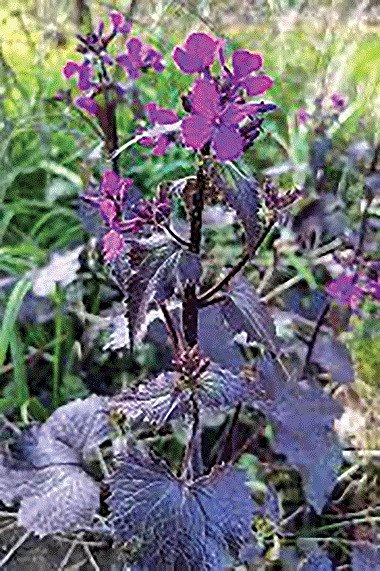March Gardening Journal: Plant of The Month – Lunaria annua 'Chedglow'
March 1st, 2024
Come early march there is a glimmer of hope in the air as the days seem brighter and it feels like Winter is almost behind us. The plants in our gardens notice this change too - as the bulbs start flowering and the trees and shrubs start sprouting, we are provided with a new lease of life that helps to lift our spirits. By the end of the month, and as the weather warms up, there are more opportunities to get out and about and appreciate nature as it awakens from its winter hibernation. There are a few plants flowering at this time of year, but few with such a hot pink display as this months 'Plant of the Month'.
'Honesty' or Lunaria annua, is an old-fashioned dual-purpose plant, grown partly for its fragrant purple or white flowers in spring and early summer, but also for its unique oval and translucent seedheads, popular with dried-flower arrangers.
It's properly grown as a biennial, and makes large, well-branched plants that flower in their second year, after which it will seed itself freely around the garden. However, smaller plants can sometimes be grown as hardy annuals from an early sowing, with a smaller flower display, but very good compact seed-heads.
Lunaria ‘Chedglow’ is having its moment in late February/early March - offering the garden its first flare of colour. Their liquorice foliage has an iridescent sheen, which adds depth to the surge of spring green as the flowering spikes rise to bloom. The dark, rich violet foliage really makes this plant shine and stand out from other Lunaria cultivars available to buy or grow from seed. Biennials and annuals are useful to add a lived-in feeling and for filling space whilst slower growing perennials find their feet. In the winter months the silver penny seedheads of honesty are easily as wonderful as the flowers, catching the light and living up to their lunar imagery and so it is tempting to leave the plants standing.Be careful though, after a few years of self-seeding Be prepared to thin out the seedlings and be particular about where you want it to grow, its easy for a plant like this to be left to its own devices and run amok all over your garden.
Lunaria look best planted amongst the spring flowers of Brunnera, Narcissi, Geranium maccrorizzhum and the lime green of Euphorbia. Planting it just behind some Geranium Rozanne will also mean you are able to complement the decorative seed heads of the Lunaria with the summer flowers of the Geranium. Overall, it’s a great biennial for those you who don’t mind a plant who likes to spread about and find a home in your garden where you may not have originally intended it to be.
Jobs to be done in March:
Ornamental Garden:
• A general fertiliser could be applied over borders if felt necessary. If leaves look yellow on shrubs then give them a folate feed (liquid feed via watering can).
• Aerate lawn with a wire rake if mild and not waterlogged.
• Remove any dead, diseased or damaged growth from trees and shrubs.
• Finish mulching if not done in Autumn.
• Put manure / rose feed around all roses and check for dead, diseased or dying shoots.
• Deadhead bulbs regularly.
• Now is a good time to plant new Perennials and summer-flowering bulbs, top-dress all containers.
• Weed regularly.
• Edge/define all borders if not done already.
• Plant Roses.
• Sow hardy annuals for summer colour.
• Repair damage to lawns if necessary.
• Harden off hardy annuals sown under glass.
• Cut back any remaining growth from herbaceous/grasses left over from the winter.
• Divide summer flowering perennials like astrantia, hemorocallis, hosta etc.
• Coppice dogwoods/willows etc if not done before now.
Vegetable Garden:
• Prune Gooseberries and red and white currants. Remove deadwood and then spur prune all sideshoots back to 2 – 3 buds from the base. Shorten branch tips by one quarter.
• Direct sow shallots and onion setts.
• Harvest the last of the winter crops and compost any un-diseased debris.
• Sow aubergines, cucumbers, tomatoes and chillies in an indoor heated propagator.
'Honesty' or Lunaria annua, is an old-fashioned dual-purpose plant, grown partly for its fragrant purple or white flowers in spring and early summer, but also for its unique oval and translucent seedheads, popular with dried-flower arrangers.
It's properly grown as a biennial, and makes large, well-branched plants that flower in their second year, after which it will seed itself freely around the garden. However, smaller plants can sometimes be grown as hardy annuals from an early sowing, with a smaller flower display, but very good compact seed-heads.
Lunaria ‘Chedglow’ is having its moment in late February/early March - offering the garden its first flare of colour. Their liquorice foliage has an iridescent sheen, which adds depth to the surge of spring green as the flowering spikes rise to bloom. The dark, rich violet foliage really makes this plant shine and stand out from other Lunaria cultivars available to buy or grow from seed. Biennials and annuals are useful to add a lived-in feeling and for filling space whilst slower growing perennials find their feet. In the winter months the silver penny seedheads of honesty are easily as wonderful as the flowers, catching the light and living up to their lunar imagery and so it is tempting to leave the plants standing.Be careful though, after a few years of self-seeding Be prepared to thin out the seedlings and be particular about where you want it to grow, its easy for a plant like this to be left to its own devices and run amok all over your garden.
Lunaria look best planted amongst the spring flowers of Brunnera, Narcissi, Geranium maccrorizzhum and the lime green of Euphorbia. Planting it just behind some Geranium Rozanne will also mean you are able to complement the decorative seed heads of the Lunaria with the summer flowers of the Geranium. Overall, it’s a great biennial for those you who don’t mind a plant who likes to spread about and find a home in your garden where you may not have originally intended it to be.
Jobs to be done in March:
Ornamental Garden:
• A general fertiliser could be applied over borders if felt necessary. If leaves look yellow on shrubs then give them a folate feed (liquid feed via watering can).
• Aerate lawn with a wire rake if mild and not waterlogged.
• Remove any dead, diseased or damaged growth from trees and shrubs.
• Finish mulching if not done in Autumn.
• Put manure / rose feed around all roses and check for dead, diseased or dying shoots.
• Deadhead bulbs regularly.
• Now is a good time to plant new Perennials and summer-flowering bulbs, top-dress all containers.
• Weed regularly.
• Edge/define all borders if not done already.
• Plant Roses.
• Sow hardy annuals for summer colour.
• Repair damage to lawns if necessary.
• Harden off hardy annuals sown under glass.
• Cut back any remaining growth from herbaceous/grasses left over from the winter.
• Divide summer flowering perennials like astrantia, hemorocallis, hosta etc.
• Coppice dogwoods/willows etc if not done before now.
Vegetable Garden:
• Prune Gooseberries and red and white currants. Remove deadwood and then spur prune all sideshoots back to 2 – 3 buds from the base. Shorten branch tips by one quarter.
• Direct sow shallots and onion setts.
• Harvest the last of the winter crops and compost any un-diseased debris.
• Sow aubergines, cucumbers, tomatoes and chillies in an indoor heated propagator.
Comments (0)
No comments have been submitted yet.Why not be the first to send us your thoughts
Leave A Comment
Thank you for your comments, they will appear shortly once approved.
Recent Posts
Have You Seen...






